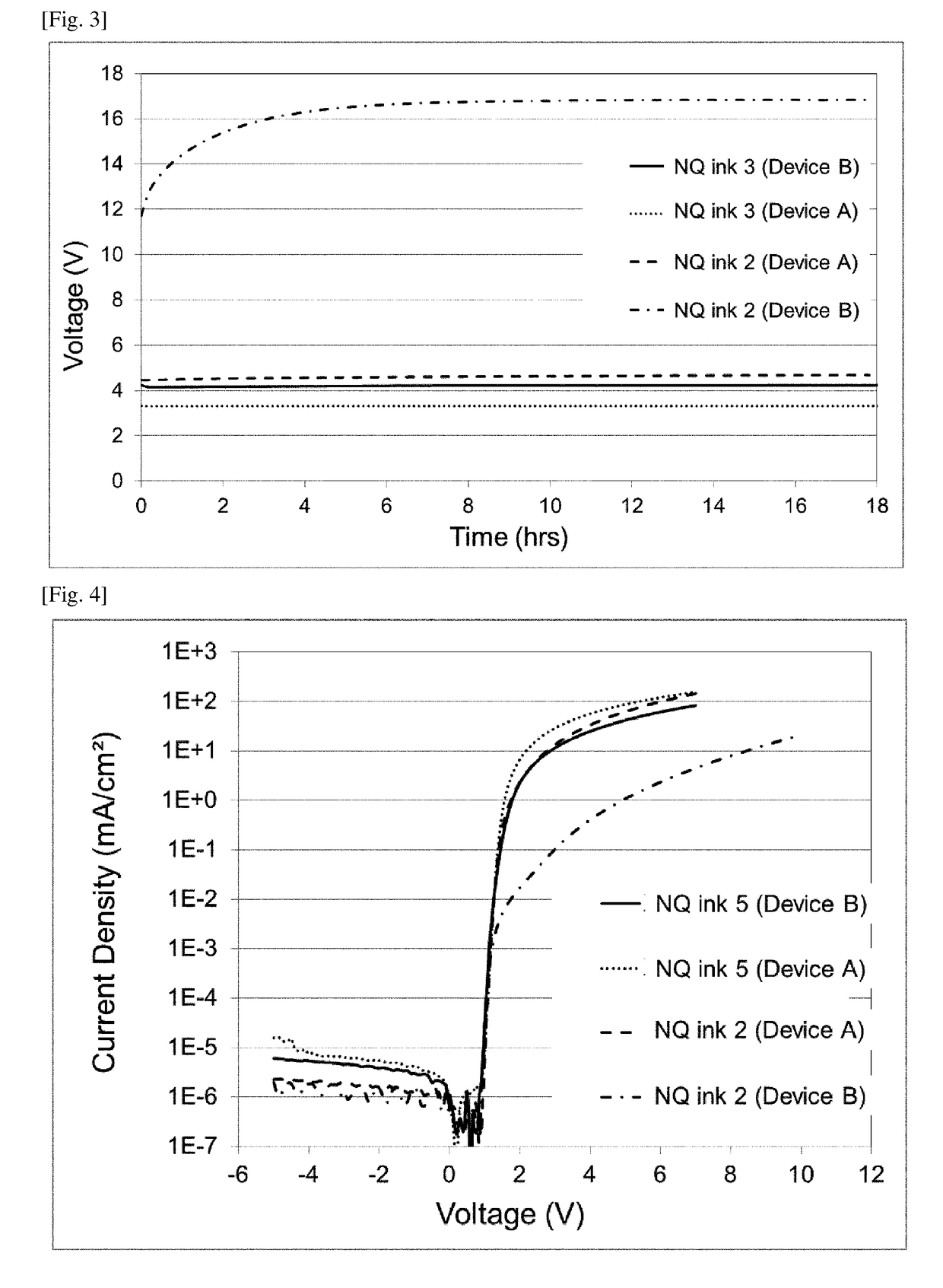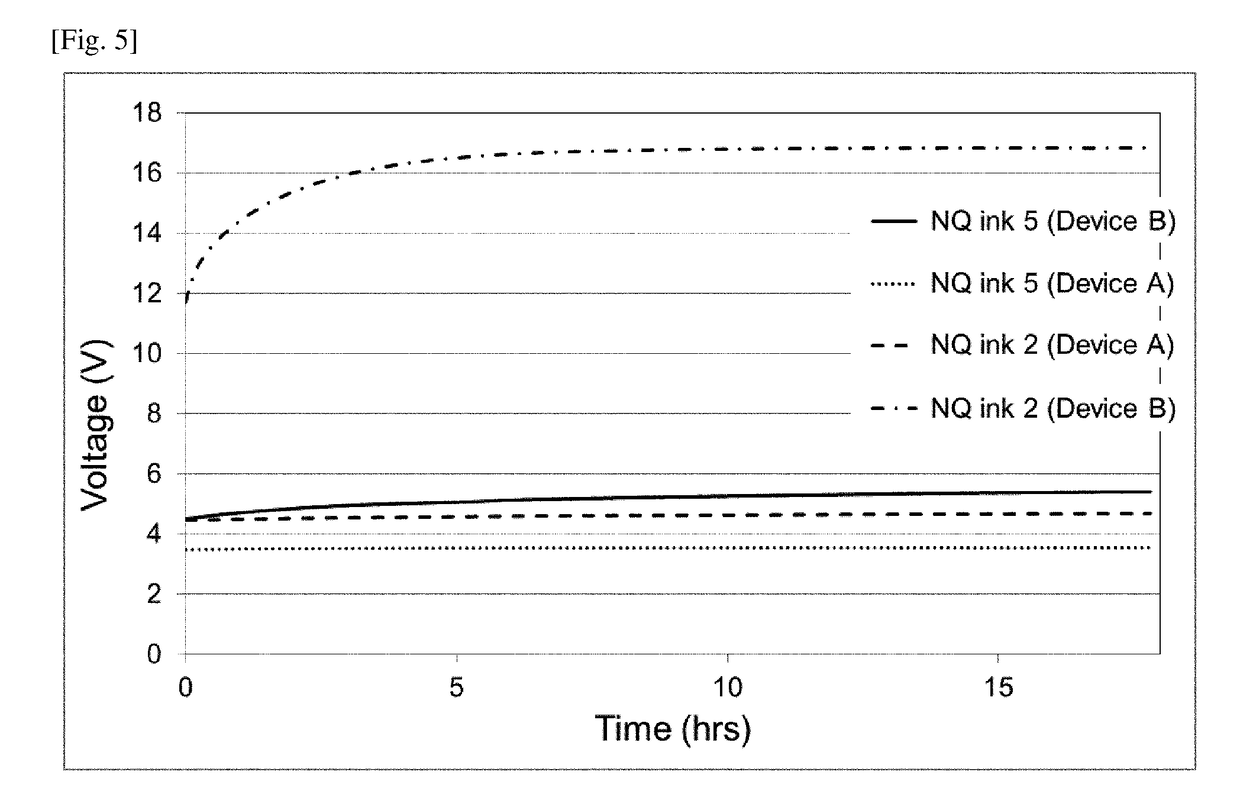Non-aqueous ink compositions containing transition metal complexes, and uses thereof in organic electronics
- Summary
- Abstract
- Description
- Claims
- Application Information
AI Technical Summary
Benefits of technology
Problems solved by technology
Method used
Image
Examples
example 1
on of Base NQ Inks
[0334]S-poly(3-MEET) amine adduct was prepared by mixing 500 g of an aqueous dispersion of S-poly(3-MEET) (0.598% solids in water), with 0.858 g of TEA. The resulting mixture was rotary-evaporated to dryness, and then further dried in a vacuum oven at 50° C. overnight. The product was isolated as 3.8 g of black powder and stored under inert atmosphere in a glovebox.
[0335]A base non-aqueous (NQ) ink, designated NQ ink 1, was prepared by combining 0.434 g of solid S-poly(3-MEET) amine adduct with 31.53 g of BDO, 47.29 g PCN, 9.55 g ACN, 5.05 g EG and 1.12 g of TEA. This combination was mixed for 30 minutes on a stir plate at ambient temperature. Next, 0.30 g of TFE-VEFS 1 was dissolved in 14.70 g of ACN by stirring at 70° C. for 20 minutes. The TFE-VEFS 1 solution was added to the S-poly(3-MEET) amine adduct mixture followed by stirring at ambient temperature for 1 hour. 15.04 g EG-ST was added and stirring continued for 1 hour to produce a clear dark blue ink. The i...
example 2
on of Inventive NQ Inks
[0337]NQ ink 1 was used as the base ink in preparing the inventive NQ inks.
[0338]0.307 g MoO2(acac)2 was added to 30.0 g of NQ ink 1 prepared according to Example 1. After stirring for 1 hour at ambient temperature, the dark blue ink was filtered through a 0.22 μm polypropylene filter to yield NQ ink 3. 0.307 g MoO2(acac)2 corresponds to 0.135 g MoO3, which is 15 wt % relative to the total weight of solids (i.e., 0.9 g) in the base NQ ink used.
[0339]Two other inventive inks, NQ ink 4 and NQ ink 5, were prepared according to the same procedure, except that the amount of MoO2(acac)2 (and thus MoO3 equivalent) used was modified. The amount of MoO3 equivalent in NQ inks 3-5 are summarized in Table 3.
TABLE 3Amount of MoO3 in NQ inksAmount of MoO3 inHIL inkNQ ink 10NQ ink 20NQ ink 315NQ ink 410NQ ink 55
example 3
ation and Properties
[0340]Films were formed by spin-coating using a Laurell spin coater at 3000 rpm for 90 seconds. On a hot plate, the films were flash annealed at 75° C. for 3 minutes in air, and then finally annealed under nitrogen atmosphere at a temperature of from 230° C. to 300° C. for 30 minutes.
[0341]The work function of films made from NQ inks 1-5 were determined using the “Photo-Electron Spectroscopy in Air” (PESA) system AC-2 apparatus, available from Riken Keiki Co. Ltd. (Japan). The test sample was mounted on the sample holder in dry air which was kept at earth potential. The dry air was supplied at constant pressure to the measurement chamber through the mist separator and the micro mist separator, a membrane air dryer and controlled by a pressure meter. The monochromatized UV beam from the deuterium lamp (constant intensity of 50 nW) was focused on the sample surface. The energy of UV photons was scanned from 4.2 eV to 6.2 eV with a step of 0.05 eV. When the energy o...
PUM
| Property | Measurement | Unit |
|---|---|---|
| Temperature | aaaaa | aaaaa |
| Temperature | aaaaa | aaaaa |
| Temperature | aaaaa | aaaaa |
Abstract
Description
Claims
Application Information
 Login to View More
Login to View More - R&D
- Intellectual Property
- Life Sciences
- Materials
- Tech Scout
- Unparalleled Data Quality
- Higher Quality Content
- 60% Fewer Hallucinations
Browse by: Latest US Patents, China's latest patents, Technical Efficacy Thesaurus, Application Domain, Technology Topic, Popular Technical Reports.
© 2025 PatSnap. All rights reserved.Legal|Privacy policy|Modern Slavery Act Transparency Statement|Sitemap|About US| Contact US: help@patsnap.com



